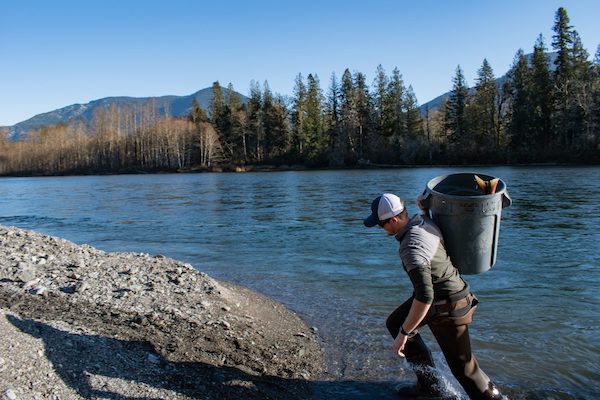
Another Chum Broodstock Program Begins, On The Skagit
At least 913 chums have been collected on the Skagit River this fall as state and tribal managers aim to increase numbers of the struggling stock of late-returning salmon that once provided important fisheries.

The new broodstock program follows on years and years of poor returns to the Skagit and is also similar to angler-WDFW efforts to boost chum runs on the Skykomish system to the south.
Starting earlier this fall and wrapping up this week, the Upper Skagit Tribe has used drift tangle nets on the middle stretches of the big river to catch the adult salmon which are then trucked by WDFW to the agency’s Marblemount Hatchery for spawning, incubation, rearing and release.
“Hatchery programs can be essential when, despite harvest restrictions, populations don’t recover on their own,” the Northwest Indian Fisheries Commission today reported on its news blog, nwtreatytribes.org.
Per the blog, tribal and state chum fisheries have been closed since 2007.
The program is being performed under a National Marine Fisheries Service-approved hatchery genetic management plan, given the watershed’s ESA-listed Chinook and steelhead. Federal funding is being used to kick start the effort.
WDFW spokesman Chase Gunnell last month said the effort would be “highly coordinated between Marblemount Hatchery staff, and boat, shore, and truck transport crews representing all the co-managers.” Anglers were asked to avoid gear conflicts during the extended coho fishery.

Plans call for as many as 500 chums to be collected in odd years – when pink salmon tend to flood the system – and as many as 1,600 in even-numbered years.
Previous to this fall, the Upper Skagit, Sauk-Suiattle and Swinomish Tribes operated a small-scale, self-funded program that collected 280 and 137 chums in 2020 and 2021, respectively, for rearing at Marblemount.
Upper Skagit elder and tribal natural resources director Scott Schuyler said his tribe’s goal with the broodstock effort “is to see the dog salmon return to its historical place of significance in our culture,” according to the blog.
After building from lower levels in the 1960s and ’70s, Puget Sound chum runs peaked in the early 2000s, providing wonderful October and November fishing – mostly but not entirely catch-and-release – on systems like the Skagit, Stillaguamish, Snohomish, Duwamish-Green and others, but they’ve been poorer over the last decade, including “historically low” returns to Hood Canal in 2019.
Down on the Skykomish, this year’s goal was to collect 500 chums, split equally between bucks and hens, for rearing at the Wallace Hatchery between Startup and Gold Bar. While WDFW stated that more time is needed to determine the program’s effectiveness at boosting returns, in the meanwhile it was serving as “a model of collaboration.
“The big takeaway I have from this program is that if you see a problem on your local river, don’t just complain about it. Contact fish and wildlife, talk to your fellow anglers, and work together to try to find a solution,” stated fishing guide Charlie Cooper, who brought the idea to WDFW.
Chums are unique in that their freshwater lifecycle is so short relative to their ocean stage, spending just a few weeks in the rivers as returning adults and only a “few days” as fry after hatching.

